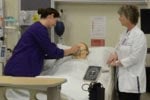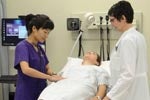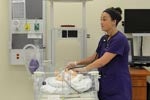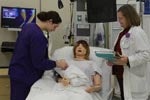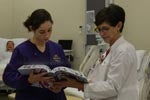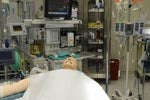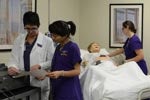Lab Descriptions
Our eight Concepts Integration Labs include three standard rooms used for skills, health assessment and procedural training; three general simulation rooms; one simulated operating room; and one anesthesia teaching lab. Our labs are equipped with mounted video cameras, and several of the rooms include an observation area that allows faculty and staff to view simulations so that students can be debriefed following each session.
Our eight Concepts Integration Labs include three standard rooms used for skills, health assessment and procedural training; three general simulation rooms; one simulated operating room; and one anesthesia teaching lab. Our labs are equipped with mounted video cameras, and several of the rooms include an observation area that allows faculty and staff to view simulations so that students can be debriefed following each session.
Students working in the labs learn through a variety of educational formats, including:
- collaborative practice,
- independent study,
- role play and
- peer-to-peer, faculty, and staff demonstrations.
Room 2100: Foundations Lab
This lab is equipped with several static manikins, two Laerdal adult VitalSims, and task trainers for skills practice. The beds are real hospital beds, and the stations are set up with a bedside table and over bed table, just as you would find in a hospital room. There are stand-up computer stations at each bed for documentation practice or skills videos. All labs (except 2102) are equipped with compressed air to allow simulation of medical air and oxygen, as well as suction. All labs are technology integrated – they have a computer at the podium which operates video and sound recording and playback with monitor. This technology is useful for debriefing after a simulation. The room houses mobility aides such as wheelchairs, walkers, a Hoyer lift, and a Guldman automated ceiling lift for practice in transferring patients in and out of bed. There are medication carts and linen carts for student use.
Sometimes a SimMan simulates a bariatric patient, resting comfortably in our specifically made bariatric bed. Our partner program, ECU Health Medical Center, has a bariatric surgery program that draws patients from across the region. We have integrated bariatric patient care teaching and simulations into our labs, hence the need for a bariatric manikin.
Room 2102: Health Assessment Lab
This health assessment lab is set up like an ED, Urgent Care, or doctor’s office, with cubicles and curtains for privacy. Each station is equipped with otoscopes (ear, nose, and throat) and ophthalmoscopes (eye), as well as stand-up computer stations for documentation as well as skills videos. Rather than beds, the cubicles have exam tables to simulate an exam room. There is one Laerdal VitalSim child manikin with its own heart and lung sounds trainer for student practice. Additionally, there is a skeletal model in this lab. You will also see the SAM II Auscultation Manikin which has realistic normal and abnormal heart and lung sounds for student practice.
Room 2106: Clinical Simulation Lab with Observation
This lab has a two-way mirror connected to an external observation room for formative and evaluative scenarios. There are three Laerdal high-fidelity manikins in the lab, including SimMan 3G. These manikins can talk, cough, breathe, and actually have pulses, as well as vital signs which are displayed on the monitors over the beds. There are monitors and medical air, oxygen, and suction on the columns above the patient to simulate what the student would encounter in a real patient setting in the hospital. You will notice cameras and microphones in the ceiling to videotape student scenarios for debriefing and as a teaching tool. There are medication carts and linen carts.
Room 3100: Neonatal Intensive Care Unit/Midwifery/Pediatrics Lab with Observation
This room has our Noelle birthing manikin with her baby, Hal, in a birthing bed; two Laerdal high-fidelity baby manikins (one in an isolette and the other in a warmer). There are frequently one to two Laerdal high-fidelity adult manikins a birthing Victoria and SimJunior manikins. The lab has a two-way mirror connected to a control room which is used for operating simulations. There are monitors at each bed and warmer, as well as medical air, oxygen and suction. Stand-up computer stations for documentation or skills video viewing are present. As in most labs, there are medication carts and linen carts. This room also has cameras and microphones in the ceiling for debriefing and teaching.
Room 3102: Acute Care Lab with Observation
This lab is equipped with one Laerdal high-fidelity SimMan and monitor above the bed and several static manikins. More advanced skills are practiced in this lab: IV therapy, blood administration, nasogastric tube insertion, chest tubes, tracheostomy care, and heart rhythms. The lab also contains multiple static IV arms for IV insertion practice. There are emergency medications in this lab as well as a “crash” cart with a defibrillator. As with the other labs, there are stand-up computer stations for documentation or skills video viewing, along with medical air, oxygen, and suction. To accommodate simulation videotaping, this lab has ceiling mounted cameras and microphones for instruction and debriefing.
Room 3104: Anesthesia Classroom
The Anesthesia Classroom is used both as a classroom and a lab. There are task trainers for improving skills in patient intubation, peripheral nerve blocking, and spinal and epidural catheter insertion. At times, this room also has a Laerdal SimBaby or a Laerdal high-fidelity SimMan for practicing post-anesthesia recovery. These two manikins are sometimes used in the anesthesia lab in room 3106.
Room 3106: Operating Room Lab with Observation
This room is the “crown jewel” of all the labs in the College of Nursing. The room is set up just like an operating room in a hospital, complete with monitors, anesthesia delivery machines, operating room tables and cabinets, instrument tables, crash cart, and operating room lamps mounted in the ceiling. The star of this room is the Laerdal SimMan 3G. This manikin is very life-like: he has tears; his lips turn blue; his pupils react to light; he can salivate and have seizures; and, of course, he has all the other great functions of a SimMan such as talking, coughing, breathing, and having pulses. This room also has a laryngoscope and a Glidescope – as used in a hospital Operating Room – for assistance in intubation. You will notice there is a two-way mirror dividing this room from the observation room. This room is used both for operating the SimMan and observing simulations. The entire operating suite is equipped with audio-visual recording equipment, such as that found in the other labs. In addition, live video can be streamed from this lab into the anesthesia conference room across the hall so that students can watch each other as they perform
Room 4165: Overflow Lab
This final lab is supplied with three stretchers like an Emergency Department bay. Three static manikins are in place for basic and advanced undergraduate skills. It is also used for student remediation, including skills practice and simulations with standardized patients. It is equipped with a monitor, computer, and Internet for viewing videos and checking information. It has a compu-caddy for Sign-ins for practice labs and video cameras for videography of skills. An observation room is to the right of the anteroom.
